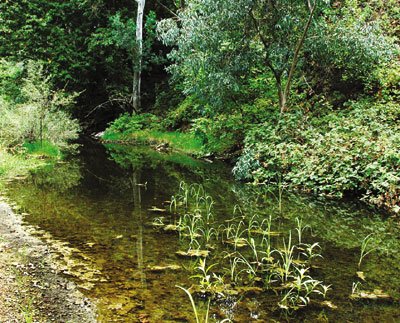In a classic battle of wills, landowners and the Santa Clara
Valley Water District are at odds over how much human control
should be exercised over local creeks to keep property safe from
flooding.
Gilroy – In a classic battle of wills, landowners and the Santa Clara Valley Water District are at odds over how much human control should be exercised over local creeks to keep property safe from flooding.
On one side is the livelihoods of farmers, who could lose crops and topsoil. On the other are state officials, environmentalists and anglers, concerned that creek-clearing methods could lead to the destruction of sensitive ecosystems.
While both sides agree flood-prevention measures are necessary, what keeps them apart is also a rift between time-worn practices and modern ideals.
For a nearly 100 years, Joe Rizzuto’s family has lived on and farmed off Monterey Frontage Road, alongside Uvas Creek in the south end of Gilroy. He and neighbor Joe Filice said they have both seen fast-growing non-native species such as Arundo, a reed, and Eucalyptus trees, take over the stream, obstructing its flow to the point that a heavy rainy season could turn into a flood threat.
In 1982, the water district came forward with easement proposals meant to give it control of the creeks to build levees and construct other flood prevention measures. Up until then, Rizzuto and other landowners had done their own creek-cleaning, ripping out trees and plants as they saw fit. Comfortable with his own methods, Rizzuto refused to sign, unconvinced the district could be counted on to keep the creek clean.
Now 25 years later, he’s insisting he was right.
“It’s a mess down there,” Rizzuto said. “The overgrowth, the Eucalyptus, the bamboo, stuff like this should have been taken out years ago.”
But plants aren’t the only contributor to flood concerns. As a farmer with several hundred acres next to the Carnadero Creek, southeast of Gilroy, Steve Malatesta blamed the continued construction that covered water-soaking ground with asphalt. Typically rain water would percolate through the soil, but with the abundance of asphalt and concrete, that rain water has nowhere to go but into the storm drains that feed into local creeks.
Invasive species are a regional challenge, said Mark Klementic, the water district’s deputy operating officer in charge of the Uvas/Llagas watershed.
He and a team of workers have been working their way downstream for several years to remove the invasive plants and promised they would make a special trip to Rizzuto’s property to assess the situation. The burden of state and federal protection requirement, however, makes any work difficult.
“We don’t do maintenance the way it used to be done 40 or 50 years ago because we recognize the value of the creek and try to stay out of it,” he said. “It’s a real balance.”
One of the easier ways to curb the growth of unwanted species – the use of herbicides – has been out of the question for nearly 30 years because the chemicals could wind up in the water, as well as killing untargeted native plants.
Other sanctions made flood control work difficult for the district. If workers move dirt around when pulling up a tree, they need a permit from the federal Army Corps of Engineers.
Recognizing that floods were a very real threat, state and federal agencies such as National Marine Fishery Service and Central Coast Regional Water Quality Control Board gave Klementic clearance in 2002, lifting many restrictions for a period of 10 years to clear streams and use herbicides if necessary.
“There are number of things we have done to try to minimize impact but still get our work done,” Klementic said.
Today’s conservation concerns force anyone who works in the valley’s watersheds – be it to clear brush or rescue fish from receding water pools – to undergo training to make sure they disturb the land as little as possible.
That is a far cry from past creek-clearing attempts: Less than a half-century ago, bulldozers would rip out unwanted trees and “rifling” machines would claw at the creek bed so the water could penetrate it, said Fred Angelino, former president of the now-defunct South Valley Water Conservation District.
In Rizzuto’s youth, if a driveway needed repaving, residents would often dredge the creek for gravel, a free and abundant alternative to tar, he said.
Today, the state would levy a heavy fine on such activity.
The steelhead trout is one endangered species living within the valley’s watersheds, Klementic said. A fallen tree that obstructs waterflow may be seen as a flood hazard by landowners, but it’s a perfect hiding place for predatorial fish such as steelhead.
“You can’t make everyone happy,” Malatesta said. “Property owners only see one version, the water district sees another and the environmentalists see another way.”
Perry Shirley is a news intern and currently attends San Francisco State University. He can be reached at (408) 846-6452 or ps******@***********rs.com.













